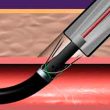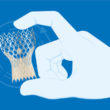The Hydra CE has shown favorable one year efficacy for the new transcatheter aortic valve model, with large effective orifice and low transvalvular gradient associated to an acceptable complications rate. With this study, the Hydra will obtain the CE mark and go after FDA approval (just as all new devices). This study looked at safety...
CHOICE-CLOSURE | Which Closure Device for TAVR is Better?
In patients who undergo transcatheter aortic valve replacement (TAVR) through transfemoral access, a closure device based on plug technology (MANTA VCD) is associated with a higher chance of access-related complications, but with shorter hemostasis time compared with a device with suture technology such as ProGlide VCD. Nowadays, most patients undergo TAVR through transfemoral access. Percutaneous...
TAVR vs Sutureless Surgical Aortic Valve Replacement in Low-Risk Patients
Sutureless surgical aortic valve replacement (SU-SAVR) has been designed to make surgical valve replacement easier and faster, especially compared against conventional biological valves which require multiple sutures; their rapid deployment translates into reduced cross-clamp and operative time. These valves shorten operating time and are less invasive than conventional surgical valves. Except for sternotomy incisions, they...
Is Troponin Elevation After TAVR Related to Mortality?
Troponins have long had diagnostic value not only for infarction. Their ability to predict mortality is well established for all cardiac conditions. Moreover, it has been demonstrated in all critically ill patients, including patients with COVID-19, regardless of the triggering condition. While their significance in COVID cases is backed by the literature, there was not...
Fluoroscopy vs. Ultrasound Guided Femoral Access in TAVR
Ideally, we will not puncture the femoral artery blindly if we are planning to use a big caliber releasing device and a percutaneous closure device during TAVR. The risk of a high or low puncture or the presence of a lateral branch compromising the puncture site might become a major vascular and bleeding complication. There...
Watch Again Challenges in TAVR – Severe Coronary Disease and Coronary Occlusion
Watch Again Challenges in TAVR – Severe Coronary Disease and Coronary Occlusion on our youtube account. Challenges in TAVR – Severe Coronary Disease and Coronary Occlusion
The FDA Approves a Third Device in the TAVR Race
The Portico self-expanding graft has obtained FDA approval and can now compete as one of the three options available in clinical practice for transcatheter aortic valve replacement (TAVR) in the United States. For the time being, its indication will have some restrictions: for example, it can only be used in high-risk patients (unlike CoreValve and...
TAVR and Anticoagulation: Direct Anticoagulant Agents or Vitamin K Inhibitors?
In some patients, using an anticoagulant agent is not an option, it is just prescribed. Based on the French TAVR registry, this research compared long-term mortality, bleeding, and ischemic events after valve implantation. A comparison was made between TAVR and direct vs. classic anticoagulant agents—good old proven and reversible vitamin K inhibitors. Cardiologists, hematologists, clinicians, and...
Thrombotic and Bleeding Risk after TAVR: Quick Tips to Stay Up to Date
Transcatheter aortic valve replacement (TAVR) is an increasingly frequent option for patients with severe aortic stenosis across the entire risk spectrum. However, TAVR involves bleeding and thrombosis risk and therefore calls for an optimal adjuvant treatment. Any scheme is complex if we take into account most patients undergoing TAVR are generally elderly and have multiple...









